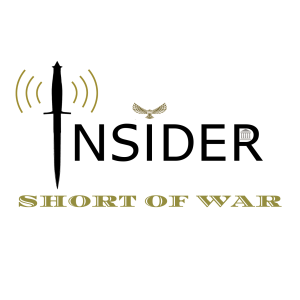Insider: Short of War
Welcome to the Irregular Warfare Initiative’s Insider: Short of War, where IWI transforms its thought provoking articles into compelling audio pieces. Our podcast bridges the gap between scholars, practitioners, and policymakers, offering in-depth analysis and expert commentary on the dynamic world of irregular warfare. Stay informed and engaged with the latest insights from leading voices in the field, right at your fingertips.
Episodes

Thursday Jul 03, 2025
Thursday Jul 03, 2025
In this audio version, we examine how Hezbollah’s hybrid warfare model is unraveling under the strain of leadership loss, reduced Iranian support, political shifts in Lebanon, and exposure to illicit trade. The episode dissects how irregular warfare theory applies to Hezbollah’s relative decline and why this matters for global security.

Tuesday Jul 01, 2025
Tuesday Jul 01, 2025
This episode explores African perspectives on irregular warfare based on a new study by the U.S. Irregular Warfare Center. Drawing on interviews with defense leaders from Angola, Nigeria, Kenya, Liberia, and Zambia, we discuss how these nations define IW, what threats they face, and how colonial history and regional instability shape modern conflict. The findings offer critical lessons for U.S. policymakers and warfighters seeking effective partnerships across Africa.

Tuesday Jun 24, 2025
Tuesday Jun 24, 2025
This podcast episode explores how Sweden’s civil defense handbook and Latin America’s disaster response strategies reveal critical lessons in national crisis preparedness. From irregular warfare awareness to community-based drills, this is a must-listen for anyone interested in security, resilience, and public policy.

Friday Jun 20, 2025
Friday Jun 20, 2025
In this podcast episode, we explore the long history of airfield raids and drone warfare, pushing back against the notion that modern tech revolutionizes war. Drawing on examples from WWII to the war in Ukraine, this article-turned-audio examines why understanding historical context is essential for grasping today’s military dynamics.

Wednesday Jun 18, 2025
Wednesday Jun 18, 2025
In this episode, we explore China’s indirect approach to the First Indochina War through Xiaobing Li’s Building Ho’s Army, analyzing how Beijing trained, armed, and advised North Vietnamese forces to defeat the French. The discussion dives into the strategic context of China's geostrategic encirclement, the PLA's pivotal role in military advising, and how this historical example shapes our understanding of Chinese power projection today.

Tuesday Jun 10, 2025
Tuesday Jun 10, 2025
In this episode, we explore how historical lessons from the Balkan wars can inform Ukraine’s struggle for peace amid Russia’s hybrid warfare. We break down why irregular warfare—not just legal agreements—must guide any future resolution, and what steps Ukraine and its allies can take to build lasting resilience and sovereignty.

Thursday Jun 05, 2025
Thursday Jun 05, 2025
This podcast explores why U.S. military advising missions succeed or fail, drawing on Frank Sobchak’s in-depth case studies from El Salvador to Afghanistan. We examine key variables such as advisor relationships, mission design, and institutional reform. Whether you're a policy expert or a military professional, this episode breaks down critical lessons for future advising efforts.

Wednesday Jun 04, 2025
Wednesday Jun 04, 2025
This episode explores “security hybridization,” a growing global trend where states engage both the U.S. and China for different types of security support. We examine how this dual cooperation shapes policy, highlights contrasting approaches to internal versus external threats, and raises implications for practitioners working in irregular warfare and security force assistance.

Thursday May 01, 2025
Thursday May 01, 2025
In this narrated article, we explore the major themes of Winning Without Fighting, a book that challenges traditional U.S. national security thinking. The authors argue for a new strategic approach rooted in long-term competition and national resilience in the face of global shocks like pandemics and climate disasters. From critiques of strategic culture to actionable recommendations on information warfare and resilience building, this podcast provides a timely breakdown of how the U.S. can remain competitive in a crisis-prone world.

Thursday Apr 24, 2025
Thursday Apr 24, 2025
In this episode, we explore how disjointed Army Security Cooperation efforts—across SFABs, ARSOF, and SPP—are missing the mark. From command silos to overlapping missions, we unpack why better coordination is critical to building lasting partnerships and deterring adversaries. Learn about three powerful structural fixes that could unleash the full potential of the Army’s global engagements.








